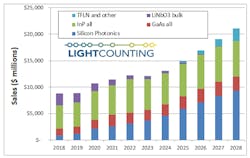The era of silicon photonics is nigh: LightCounting
The percentage of optical transceivers that leverage silicon photonics will double from 24% in 2022 to 44% by 2028, LightCounting predicts in its newly released May 2023 Silicon Photonics & Co-Packaged Optics report. Optical device designers also will increase their use of silicon photonics as an integration platform in support of such emerging materials and technologies such as thin-film lithium niobate (TFLN), barium titanate (BTO), and electro-optic polymers, the market research firm states in the ninth edition of the new report.
While the photonic integration approach hasn’t fulfilled the more breathless hype it attracted in its early days, silicon photonics is now a mainstream approach within the optical transceiver ecosystem, LightCounting suggests. As the chart above illustrates, the use of silicon photonics will increase steadily over the next few years to support nearly half the market.
Emerging uses for silicon photonics should help drive this trend, with LightCounting pointing toward linear drive pluggable optics and co-packaged optics as a pair of potential catalysts. The market researchers acknowledge that not all such optical modules will use silicon photonics, but state that “SiP is the current front runner and the ideal integration platform for new materials as well.” This status is particularly strong for the linear-drive pluggables, as alternatives such as GaAs directly modulated lasers (DMLs) and InP electro-absorption modulated lasers (EMLs) are more “non-linear” devices.
The report includes a new forecast for linear-drive and co-packaged optics by reach and data rate. While the dominance of conventional re-timed pluggables won’t be threatened within the next five years at least, LightCounting believes, the emerging challengers will represent more than 30% of the total 800G and 1.6T ports deployed in 2026-2028, according to the report.
For related articles, visit the Business Topic Center.
For more information on optical components and suppliers, visit the Lightwave Buyer’s Guide.
To stay abreast of optical communications technology, subscribe to Lightwave’s Enabling Technologies Newsletter.

Stephen Hardy | Editorial Director and Associate Publisher, Lightwave
Stephen Hardy is editorial director and associate publisher of Lightwave and Broadband Technology Report, part of the Lighting & Technology Group at Endeavor Business Media. Stephen is responsible for establishing and executing editorial strategy across the both brands’ websites, email newsletters, events, and other information products. He has covered the fiber-optics space for more than 20 years, and communications and technology for more than 35 years. During his tenure, Lightwave has received awards from Folio: and the American Society of Business Press Editors (ASBPE) for editorial excellence. Prior to joining Lightwave in 1997, Stephen worked for Telecommunications magazine and the Journal of Electronic Defense.
Stephen has moderated panels at numerous events, including the Optica Executive Forum, ECOC, and SCTE Cable-Tec Expo. He also is program director for the Lightwave Innovation Reviews and the Diamond Technology Reviews.
He has written numerous articles in all aspects of optical communications and fiber-optic networks, including fiber to the home (FTTH), PON, optical components, DWDM, fiber cables, packet optical transport, optical transceivers, lasers, fiber optic testing, and more.
You can connect with Stephen on LinkedIn as well as Twitter.
